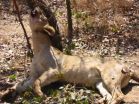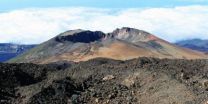(Press-News.org) New York, NY and Hyderabad (India) – A new report published today by Panthera confirms that widespread illegal hunting and the bushmeat trade occur more frequently and with greater impact on wildlife populations in the Southern and Eastern savannas of Africa than previously thought, and if unaddressed could potentially cause a 'conservation crisis.' The report challenges previously held beliefs of the impact of illegal bushmeat hunting and trade in Africa with new data from experts.
While the bushmeat trade has long been recognized as a severe threat to the food resources of indigenous peoples and to wildlife populations in the forests of West and Central Africa, far less attention has been focused on the issue in African savannas, in part due to the misconception that illegal hunting for bushmeat in African savannas is a small-scale phenomenon practiced for subsistence living.
Motivated by a growing concern about the impacts of illegal hunting and the bushmeat trade in these savannas, Panthera, the Zoological Society of London and the Wildlife Conservation Society organized a workshop in Johannesburg, South Africa attended by key wildlife experts to identify the drivers of illegal hunting and the bushmeat trade, and the interventions necessary to mitigate these issues.
TRAFFIC, the wildlife trade monitoring network, has highlighted a new report, entitled Illegal Hunting and the Bush-Meat Trade in Savanna Africa: Drivers, Impacts and Solutions to Address the Problem, at the Convention on Biological Diversity's (CBD) eleventh meeting of the Conference of the Parties (CBD, CoP 11) in Hyderabad, India. This report provides the first comprehensive overview of the threat posed by illegal hunting and the bushmeat trade in African savannas for twelve years, and provides new insights into just how grave the issue has become.
Lead author and Panthera's Lion Program Policy Initiative Coordinator, Dr. Peter Lindsey, explained, "Dramatically more effort, focus and resources need to be invested to address the illegal hunting and the bushmeat trade. In the absence of such an effort, one of Africa's most valuable resources, the continent's wildlife and comparative advantage, will wane rapidly and disappear from many areas."
The workshop's findings confirm that illegal hunting for bushmeat is emerging as one of the most severe threats to wildlife in several countries in the savanna biome. Dramatic ecological consequences include local disappearances of many species within and outside protected areas, reductions in the sizes of protected areas and, in some cases, complete collapse and disappearance of wildlife populations. Furthermore, scientists estimate that as wildlife populations dwindle, the pressure on remaining populations, including those in protected areas, is likely to increase.
Along with these damning ecological impacts, the report shows that the bushmeat trade imparts serious negative economic and social impacts on indigenous peoples and local communities. According to the report, the bushmeat trade is foreclosing options for developing wildlife-based tourism and other forms of wildlife-based land use in many areas, threatening a primary potential driver for economic growth and the generation of employment for local communities.
Furthermore, the report highlights the impact of the bushmeat trade on food security within local communities. While the bushmeat trade currently contributes to household protein needs in many local regions, the practice is not sustainable, due to wasteful and unselective hunting methods, and a lack of regulation of harvest. By contrast, the report explains that regulated legal hunting of wildlife has the potential to sustainably generate massive quantities of meat protein for local households.
The report additionally outlines the infrastructure and logistics of illegal bushmeat hunting and trade. Snaring, or the setting of wire snares, is the most common illegal hunting method and is highly effective, difficult to control, and has severe impacts on wildlife due to its non-selectivity and frequent incidents of severe, non-lethal wounding of animals. Such hunting, and the subsequent trade in wildlife parts, typically occurs on a continuum – from that done to obtain meat for direct consumption and/or community trade, to large-scale commercial trade in urban centers or international markets.
Experts found that the drivers of the bushmeat trade in savanna areas are varied, and include: increasing demand for bushmeat in rural and urban areas; human encroachment on wildlife areas; inadequate penal systems and lack of enforcement; lack of alternative livelihoods and food sources for people living in or near wildlife areas; lack of clear rights over wildlife or land; political instability, corruption and poor governance; demand for wildlife body parts for traditional medicine and ceremonies; and abundant supplies of wire (which is used by bushmeat hunters to make snares).
Finally, the report outlines a variety of solutions required to mitigate illegal bushmeat hunting and trade, including: land use planning to ensure retention of wilderness areas far from human populations; measures to enable communities to benefit legally from wildlife in a sustainable way; improved legal protection of wildlife and law enforcement; the provision of alternative livelihoods and food sources; and measures to reduce the availability of wire to create snares.
At CBD CoP11, Roland Melisch, Head of TRAFFIC's delegation in Hyderabad (India), called upon Parties to include this essential document on bushmeat on the agenda for considerations by the Parties, "A comprehensive set of recommendations on sustainable use of wild meat has been negotiated by Parties, experts and indigenous peoples and local communities through a multi-year process. It is now time for Parties to CBD to act and adopt those recommendations."
INFORMATION:
Learn about Panthera's Remove a Snare campaign.
About Panthera
Panthera, founded in 2006, is the world's leading organization devoted exclusively to the conservation of wild cats and their ecosystems. Utilizing the expertise of the world's premier cat biologists, Panthera develops and implements global conservation strategies for the largest, most imperiled cats – tigers, lions, jaguars, and snow leopards. Representing the most comprehensive effort of its kind, Panthera works in partnership with local and international NGOs, scientific institutions, local communities and governments around the globe. Visit Panthera.
About TRAFFIC
TRAFFIC, the wildlife trade monitoring network, works to ensure that trade in wild plants and animals is not a threat to the conservation of nature. TRAFFIC is a strategic alliance of IUCN and WWF. Visit TRAFFIC.
Report -- illegal hunting and trade of wildlife in savanna Africa may cause conservation crisis
2012-10-12
ELSE PRESS RELEASES FROM THIS DATE:
New weapons detail reveals true depth of Cuban Missile Crisis
2012-10-12
The Cuban Missile Crisis took place 50 years ago this October, when US and Soviet leaders pulled back from the very brink of nuclear war. This was the closest the world has come to nuclear war, but exactly how close has been a matter of some speculation. The conflict, itself, has been analyzed and interpreted, but the number and types of nuclear weapons that were operational have not. According to fresh analysis available today in the Bulletin of the Atomic Scientists, published by SAGE, senior experts calculate the nature of weapons capabilities on both sides, and write ...
GMES for Europe
2012-10-12
The potential of GMES for crisis management and environmental monitoring is highlighted in a new publication with users demonstrating the importance of Earth observation data to European regions.
The joint ESA-NEREUS (Network of European Regions Using Space Technologies) publication is a collection of articles that provide insight into how the Global Monitoring for Environment and Security (GMES) programme is being used in new applications and services across Europe.
The articles, prepared by regional end-users, research institutes and industry providers from 17 different ...
Development of 2 tests for rapid diagnosis of resistance to antibiotics
2012-10-12
With their excellent sensitivity and specificity, the use of these extremely efficient tests on a world-wide scale would allow us to adapt antibiotic treatments to the individual's needs and to be more successful in controlling antibiotic resistance, particularly in hospitals. These works were published in September in two international reviews:
Emerging Infectious diseases and The Journal of Clinical Microbiology.
These diagnostic tests will allow rapid identification of certain bacteria that are resistant to antibiotics and hence:
Allow us to better adapt the treatment ...
Scientists identify trigger for explosive volcanic eruptions
2012-10-12
Scientists from the University of Southampton have identified a repeating trigger for the largest explosive volcanic eruptions on Earth.
The Las Cañadas volcanic caldera on Tenerife, in the Canary Islands, has generated at least eight major eruptions during the last 700,000 years. These catastrophic events have resulted in eruption columns of over 25km high and expelled widespread pyroclastic material over 130km. By comparison, even the smallest of these eruptions expelled over 25 times more material than the 2010 eruption of Eyjafjallajökull, Iceland.
By analysing ...
The body's own recycling system
2012-10-12
Almost everything that happens inside a cell, including autophagy, is tightly regulated on a biochemical level. Like that, the cell makes sure that processes only take place when they are needed and that they are shut off when the need has expired. "Inside the cell, there exists a network of molecules. Between them, information is constantly being exchanged," says Schmitz, head of the research group "Systems-oriented Immunology and Inflammation Research" at HZI, who also holds a chair at the Otto von Guericke University in Magdeburg. "In a way, it looks like a big city ...
The worst noises in the world: Why we recoil at unpleasant sounds
2012-10-12
In a study published in the Journal of Neuroscience and funded by the Wellcome Trust, Newcastle University scientists reveal the interaction between the region of the brain that processes sound, the auditory cortex, and the amygdala, which is active in the processing of negative emotions when we hear unpleasant sounds.
Brain imaging has shown that when we hear an unpleasant noise the amygdala modulates the response of the auditory cortex heightening activity and provoking our negative reaction.
"It appears there is something very primitive kicking in," says Dr Sukhbinder ...
Kidney grafts function longer in Europe than in the United States
2012-10-12
Kidney transplants performed in Europe are considerably more successful in the long run than those performed in the United States. While the one-year survival rate is 90% in both Europe and the United States, after five years, 77% of the donor kidneys in Europe still function, while in the United States, this rate among white Americans is only 71%. After ten years, graft survival for the two groups is 56% versus 46%, respectively. The lower survival rates compared to Europe also apply to Hispanic Americans, in whom 48% of the transplanted kidneys still function after ten ...
Neuroscientists from Louisiana Tech University to present at international conference
2012-10-12
RUSTON, La. – Dr. Mark DeCoster, the James E. Wyche III Endowed Professor in Biomedical Engineering at Louisiana Tech University, will lead a team of Louisiana Tech neuroscientists in presenting a lecture at the Society for Neuroscience's (SfN) annual meeting, October 15 in New Orleans.
The lecture titled, "Randomization of submaximal glutamate stimulus to interpret astrocyte effect on calcium dynamics," will be featured as part of Neuroscience 2012 – SfN's annual meeting that provides the world's largest forum for neuroscientists to debut research and network with colleagues ...
'Invisibility' could be a key to better electronics
2012-10-12
CAMBRIDGE, Mass. — A new approach that allows objects to become "invisible" has now been applied to an entirely different area: letting particles "hide" from passing electrons, which could lead to more efficient thermoelectric devices and new kinds of electronics.
The concept — developed by MIT graduate student Bolin Liao, former postdoc Mona Zebarjadi (now an assistant professor at Rutgers University), research scientist Keivan Esfarjani, and mechanical engineering professor Gang Chen — is described in a paper in the journal Physical Review Letters.
Normally, electrons ...
Prostate cancer: Curcumin curbs metastases
2012-10-12
Powdered turmeric has been used for centuries to treat osteoarthritis and other illnesses. Its active ingredient, curcumin, inhibits inflammatory reactions. A new study led by a research team at Ludwig-Maximilians-Universität (LMU) in Munich now shows that it can also inhibit formation of metastases.
Prostate cancer is one of the most prevalent malignancies in the Western world, and is often diagnosed only after metastatic tumors have formed in other organs. In three percent of cases, these metastases are lethal. A research team led by PD Dr. Beatrice Bachmeier at LMU ...



